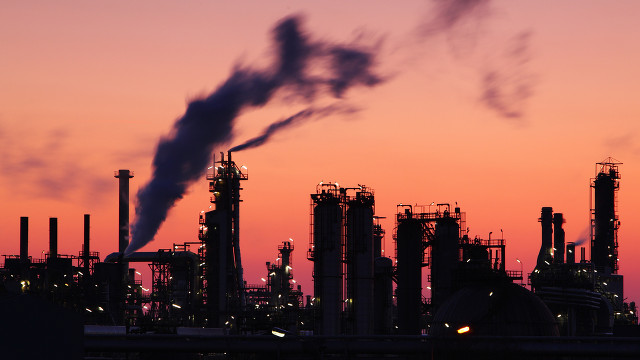SUMMARY
This is AI generated summarization, which may have errors. For context, always refer to the full article.

MANILA, Philippines – Chevron and Shell are in the top 10 list of corporations responsible for more than 60% of the world’s greenhouse gas emissions since the Industrial Revolution.
This was one of the major findings of a “groundbreaking” study by independent climate change scientist Richard Heede published last month in the scientific journal Climactic Change.
Entitled “Tracing anthropogenic carbon dioxide and methane emissions to fossil fuel and cement producers, 1854-2010,” it was shown to the media by environmental group Greenpeace on Thursday, December 12.
The report lists 90 fossil fuel companies that have spewed the most amount of greenhouse gases (GHG) like carbon dioxide and methane from 1854 to 2010. Read the report here.
These companies emit GHG every time they combust fossil fuels like oil, natural gas and coal to produce energy.
Climate change
The accumulation of GHG in the atmosphere causes global warming and climate change. Scientists have reached an overwhelming consensus that it is human (anthropogenic) activities like fossil fuel burning that have driven climate change.
More than just a predicted phenomenon, climate change is already being experienced by humans.
More ferocious typhoons, the melting of icecaps, more droughts, scorching summers, wildfires and the acidifying of oceans are fast becoming the “new normal” now that the world has entered what environmentalists and scientists call the “period of consequences.”
Heede’s study is the first of its kind to shift the focus of GHG emission sources to corporations instead of countries. But his report also names the countries from which the corporations originate. The list includes both investor-owned and state-owned companies.
All together, the 90 companies are responsible for an estimated 914 billion metric tons (GtCO2e) of carbon dioxide and methane emissions from 1854 to 2010. This is around 63% of cumulative global emissions.
The top 10 GHG emitting companies since 1854 are:
|
Entity |
Total emissions (1854-2010) in billion metric tons of CO2 equivalent (GtCO2e) |
Percent of Global Emissions |
|---|---|---|
|
Chevron, USA |
51.10 |
3.52% |
|
ExxonMobil, USA |
46.67 |
3.21% |
|
Saudi Aramco, Saudi Arabia |
46.03 |
3.17% |
|
BP, United Kingdom |
35.84 |
2.47% |
|
Gazprom, Russian Federation |
32.14 |
2.22% |
|
Shell, The Netherlands |
30.75 |
2.12% |
|
National Iranian Oil Company, Iran |
29.08 |
2.01% |
|
Pemex, Mexico |
20.03 |
1.38% |
|
British Coal Corporation, UK |
19.25 |
1.33% |
|
ConocoPhillips, USA |
16.87 |
1.16% |
Heede came up with the list by estimating the cumulative (historic) carbon pollution from each company based on the earliest production data available (1854, when combustion of coal was first recorded). He then compared it to data from the US Department of Energy’s Carbon Dioxide Information Analysis Center (CDIAC), a database for fossil fuel carbon dioxide emissions.
Looking at the geographic location of 50 of the investor-owned companies, it is apparent that most are based in developed countries. Four of these countries – USA, Australia, Japan and Canada – have been criticized by climate action groups for backtracking or not committing to carbon emission reduction targets which are vital to curbing global warming.
- USA – 21
- Canada – 6
- UK – 5
- Germany – 3
- France – 2
- Italy – 2
- Switzerland – 2
- Russia – 2
- Netherlands – 1
- Spain – 1
- Austria – 1
- Australia – 1
- Japan – 1
- Mexico – 1
- South Africa – 1
Catastrophic consequences
Unless major carbon-emitting companies and countries drastically lessen their emissions, the world will get warmer by more than two degrees Celsius, a temperature deemed “catastrophic” by scientists all over the world.
By catastrophic, they mean even more devastating storms, droughts that could threaten food and water security, and the melting of icecaps that could submerge human settlements.
Typhoon Yolanda (Haiyan), the most recent super typhoon, is said to be the strongest ever storm to make landfall and defied standard categorization. When it smashed into the Philippines early November, it claimed more than 6,000 lives and caused more than P35 billion in damages.
Despite the threat, major carbon-emitting companies show no sign of abating their extraction and combustion of fossil fuel. For instance, Shell elaborates in its website on the company’s plans to drill in the Arctic, which is thought to hold around 30% of the world’s undiscovered natural gas and 13% of the world’s undiscovered oil.
In its campaign to protect the fragile ecosystem from such exploits, environmental group Greenpeace defied Russian laws by sending a ship through an Arctic shipping route.
Green projects
Aside from the Arctic reserves, Greenpeace identified other massive fossil fuel energy projects that can push emissions so high that global warming will exceed the 2 degrees Celsius limit. They include oil expansion in the Alberta tar sands in Canada, coal expansion in Australia, China, the US and Indonesia and new gas production in the Caspian Sea.
Interestingly, some of the leading carbon-emitting companies, like Chevron and Shell, actively support “green” projects like renewable energy and include climate change and environment in their corporate social responsibility initiatives.
But Von Hernandez, director of Greenpeace Southeast Asia, is unconvinced.
“Their core business is still mainly anchored on fossil fuels and whatever investments they may have on renewables would be miniscule in context, thus making it a case of greenwashing.” – Rappler.com
Oil refinery image from Shutterstock
Add a comment
How does this make you feel?
There are no comments yet. Add your comment to start the conversation.